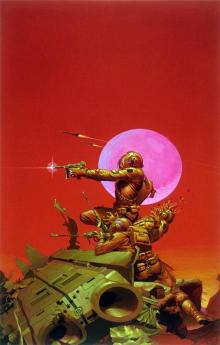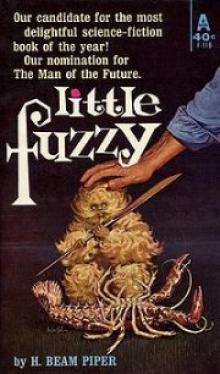- Home
- H. Beam Piper
Uller Uprising Page 2
Uller Uprising Read online
Page 2
Introduction
Dr. John D. Clark
THE SILICONE WORLD
1. THE STAR AND ITS MOST IMPORTANT PLANET
The planet is named Uller (it seems that when interstellar travel wasdeveloped, the names of Greek Gods had been used up, so those of Norsegods were used). It is the second planet of the star Beta Hydri, rightangle 0:23, declension-77:32, G-0 (solar) type star, of approximatelythe same size as Sol; distance from Earth, 21 light years.
Uller revolves around it in a nearly circular orbit, at a distance of100,000,000 miles, making it a little colder than Earth. A year is ofthe approximate length of that on Earth. A day lasts 26 hours.
The axis of Uller is in the same plane as the orbit, so that at acertain time of the year the north pole is pointed directly at thesun, while at the opposite end of the orbit it points directly away.The result is highly exaggerated seasons. At the poles the temperatureruns from 120 deg.C to a low of-80 deg.C. At the equator it remains not farfrom 10 deg.C all year round. Strong winds blow during the summer andwinter, from the hot to the cold pole; few winds during the spring andfall. The appearance of the poles varies during the year from bakeddeserts to glaciers covered with solid CO_{2}. Free water exists inthe equatorial regions all year round.
2. SOLAR MOVEMENT AS SEEN FROM ULLER
As seen from the north pole--no sun is visible on Jan. 1. On April 1,it bisects the horizon all day, swinging completely around. April 1 toJuly 1, it continues swinging around, gradually rising in the sky, thespiral converging to its center at the zenith, which it reaches July1. From July 1 to October 1 the spiral starts again, spreading outfrom the center until on October 1 it bisects the horizon again. OnOctober 1 night arrives to stay until April 1.
At the equator, the sun is visible bisecting the southern horizon forall 26 hours of the day on January 1. From January 1 to April 1, thesun starts to dip below the horizon at night, to rise higher above itduring the day. During all this time it rises and sets at the samehours, but rises in the southeast and sets in the southwest. At noonit is higher each day in the southern sky until April 1, when it risesdue east, passes through the zenith and sets due west. From April 1 toJuly 1, its noon position drops down to the north, until on July 1, itis visible all day, bisected by the northern horizon.
3. CHEMISTRY AND GEOLOGY OF ULLER
Calcium and chlorine are rarer than on earth, sodium is somewhatcommoner. As a result of the shortage of calcium there is a higherration of silicates to carbonates than exists on earth. The water isslightly alkaline and resembles a very dilute solution of sodiumsilicate (water glass). It would have a pH of 8.5 and tastes slightlysoapy. Also, when it dries out it leaves a sticky, and then a glassy,crackly film. Rocks look fairly earthlike, but the absence or scarcityof anything like limestone is noticeable. Practically all thesedimentary rocks are of the sandstone type.
All rivers are seasonal, running from the polar regions to the centralseas in the spring only, or until the polar cap is completely driedout.
4. ANIMAL LIFE
As on Earth life arose in the primitive waters and with a carbon base,but because of the abundance of silicone, there was a strong tendencyfor the microscopic organisms to develop silicate exoskeletons, likediatoms. The present invertebrate animal life of the planet is of thistype and is confined to the equatorial seas. They run from amoeba-likeobjects to things like crayfish, with silicate skeletons. Later, somespecies of them started taking silicone into their soft tissues, andeventually their carbon-chain compounds were converted to siliconetype chains, from
| | | | | | | |--C--C--C-- to O--Si--O--Si--O--Si, | | | | | | | |
with organic radicals on the side links. These organisms were atransitional type, with silicone tissues and water body fluids,resembling the earthly amphibians, and are now practically extinct.There are a few species, something like segmented worms, still to beseen in the backwaters of the central seas.
A further development occurred when the silicone chain animals beganto get short-chain silicones into their circulatory systems, held insolution by OH or NH_{2} groups on the ends and branches of thechains. The proportion of these compounds gradually increased untilthe water was a minor and then a missing constituent. The largermobile species were, then, practically anhydrous. Their blood consistsof short-chain silicones, with quartz reinforcing for the soft partsand their armor, teeth, etc., of pure amorphous quartz (opal). Most ofthese parts are of the milky variety, variously tinted with metallicimpurities, as are the varieties of sapphires.
These pure silicone animals, due to their practical indestructibility,annihilated all but the smaller of the carbon animals, and drove thecompromise types into odd corners as relics. They developed into afish-like animal with a very large swim-bladder to compensate for therather higher density of the silicone tissues, and from these fish theland animals developed. Due to their high density and resulting highweight, they tend to be low on the ground, rather reptilian in look.Three pairs of legs are usual in order to distribute the heavy load.There is no sharp dividing line between the quartz armor and thesilicone tissue. One merges into the other.
The dominant pure silicone animals only could become mobile andventure far from the temperate equatorial regions of Uller, since theyneither froze nor stiffened with cold, nor became incapacitated byheat. Note that all animal life is cold-blooded, with a negligibledifference between body and ambient temperatures. Since the animalsare silicones, they don't get sluggish like cold snakes.
5. PLANT LIFE
The plants are of the carbon-metabolism, silicate-shell type, like theprimitive animals. They spread out from the equator as far as theycould go before the baking polar summers killed them. They have normalseasonal growth in the temperate zones and remain dormant and frozenin the winter. At the poles there is no vegetation, not because of thecold winter, but because of the hot summer. The winter windsfrequently blow over dead trees and roll them as far as the equatorialseas. Other dead vegetation, because of the highly silicious water,always gets petrified unless it is eaten first. What with thequartz-speckled hides of the living vegetation and the solid quartz ofthe dead, a forest is spectacular.
The silicone animals live on the plants. They chew them up, dehydratethem, and convert their silicious outer bark and carbonaceousinteriors into silicones for themselves. When silicone tissue ismetabolized, the carbon and hydrogen go to CO_{2} and H_{2}O, whichare breathed out, while the silicone goes into SiO_{2}, which isdeposited as more teeth and armor. (Compare the terrestrial octopus,which makes armor-plating out of calcium urate instead of excretingurea or uric acid.) The animals can, of course, eat each other too, ormake a meal of the small carbonaceous animals of the equatorial seas.
Further note that the animals cannot digest plants when they are cold.They can eat them and store them, but the disposal of the solid waterand CO_{2} is too difficult a problem. When they warm up, the water inthe plants melts and can be disposed of, and things are simpler.

 The Edge of the Knife
The Edge of the Knife Genesis
Genesis A Slave is a Slave
A Slave is a Slave Last Enemy
Last Enemy Uller Uprising
Uller Uprising Ministry of Disturbance
Ministry of Disturbance Time and Time Again
Time and Time Again The Mercenaries
The Mercenaries Police Operation
Police Operation He Walked Around the Horses
He Walked Around the Horses Time Crime
Time Crime Dearest
Dearest Day of the Moron
Day of the Moron Crossroads of Destiny
Crossroads of Destiny Graveyard of Dreams
Graveyard of Dreams The Cosmic Computer
The Cosmic Computer Ullr Uprising
Ullr Uprising Operation R.S.V.P.
Operation R.S.V.P. Rebel Raider
Rebel Raider Murder in the Gunroom
Murder in the Gunroom Space Viking
Space Viking The Answer
The Answer A Planet for Texans (aka Lone Star Planet)
A Planet for Texans (aka Lone Star Planet) Little Fuzzy
Little Fuzzy Four-Day Planet
Four-Day Planet Little Fuzzy f-1
Little Fuzzy f-1 Keeper
Keeper The H. Beam Piper Megapack
The H. Beam Piper Megapack H. Beam Piper
H. Beam Piper Lord Kalvan of Otherwhen
Lord Kalvan of Otherwhen Fuzzy Sapiens f-2
Fuzzy Sapiens f-2 Fuzzies and Other People f-3
Fuzzies and Other People f-3 TIME PRIME
TIME PRIME Fuzzy Sapiens
Fuzzy Sapiens Lord Kalvan of Otherwhen k-1
Lord Kalvan of Otherwhen k-1 The Second H. Beam Piper Omnibus
The Second H. Beam Piper Omnibus